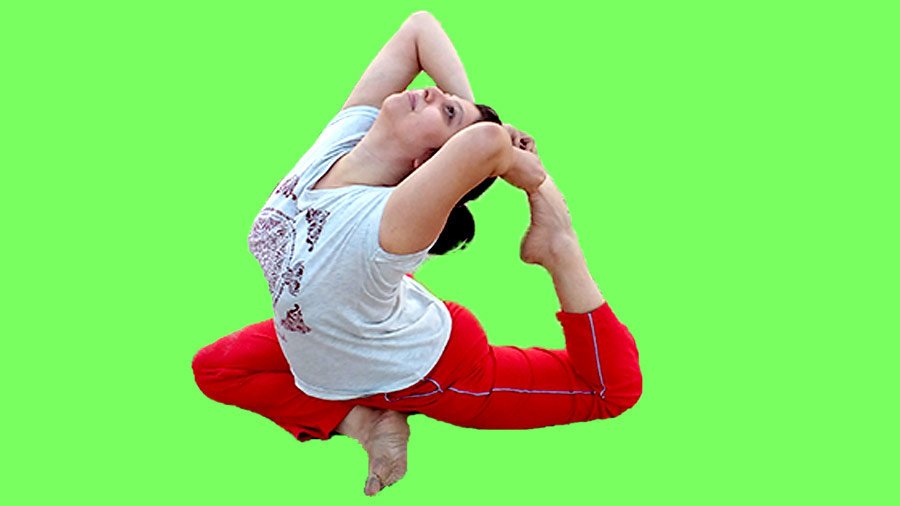Table of Contents
Eka Pada Rajakapotasana – Hip Openers Yoga
Eka Pada Rajakapotasana is also known as One-Legged King Pigeon Pose and is considered under the advanced level of Poses in Yoga. This asana derives its name from the Sanskrit words – ‘Eka’ which means ‘one’, ‘Pada’ which means ‘foot’, ‘Raja’ meaning ‘king’, ‘Kapota’ meaning ‘pigeon’ and the word ‘Asana’ meaning ‘pose’. One-Legged King Pigeon Pose is practiced in a seated position. It is one of the hip openers Yoga and a backward bend pose that makes the chest puff up. Practicing One-Legged Pigeon Pose makes hips supple and flexible by removing the accumulated stress from them.
Eka Pada Rajakapotasana Steps
- Spread a Yoga Mat on the floor and start with Adho Mukha Svanasana (Downward Facing Dog Pose) on it. This pose is also called Parvatasana, step number 5 or 8 of Suryanamaskar.
- Bring the right knee forward and place the right leg with bent knees in front of you on the floor between your hands.
- Settle your pelvis nicely to the earth.
- While your right outer thigh touches the floor bring the hip closer to the floor.
- Put the weight on the right side of the hip and square your hips to the front of the mat.
- If you feel that you are tilting to the right side then you can place a block under your right hip.
- In such a case, it will also help you to square your hips to the front of the mat.
- Straighten your left leg and rest it on the floor, connecting it to the earth.
- Arch the back slightly backward and stretch the neck and shoulders behind.
- Keep on slowly bending the back backward and pushing the hip downwards.
- Such an arch of the back will help to open the hip joints.
- Take your head back as far as you can without straining into a backbend.
- Hold this posture for a few moments.
- Bend your left leg from the knee and hold the ankle with your left hand twisting your upper body.
- After you are comfortable in the pose, twist the left elbow while holding the left toes and bring the left elbow above your head and hold on to the twist.
- Allow your left foot to come close to your back.
- Then reach with your right hand also from above your head grasping your left toes.
- Maintain the balance and do not strain.
- Now both the elbows are in a line and pointing towards the sky.
- Remain in this final pose as per your comfort.
- For still a tougher version of the pose, bend your back further and bring your head back to rest on the sole of your left foot, without straining.
- Hold this pose as per your comfort.
- Then gently release the pose adopting a downward-facing dog pose (Parvatasana, pose 5 of Suryanamaskar).
- Repeat on the left side with the same procedure.
Ek Pada Rajakapotasana Precautions
- Ek Pada Rajakapotasana is an advanced Yoga Pose and must be practiced under the guidance of an expert yoga instructor.
- This asana must be practiced only after you have been doing yoga regularly for a good period of time and have achieved good flexibility.
- One-Legged King Pigeon Pose is not for beginners.
Ek Pada Rajakapotasana Contraindications
- Ek Pada Rajakapotasana should not be performed by people suffering from ankle, knee or sacroiliac injury.
- Those practitioners who have tight hips and thighs should not practice this asana.
Ek Pada Rajakapotasana For Beginners
- Beginners may find it difficult to grasp the ankle with their hands. In such a case they should use a strap with a buckle for holding the ankle.
- While entering into the pose if the body is tilting towards the direction of the folded leg, then beginners can place a block under their hip. It will also help them to square their hips to the front of the mat.
Ek Pada Rajakapotasana Benefits
- Regular practice of Ek Pada Rajakapotasana opens the hip joint and lengthens the hip flexor.
- This asana stretches the thighs and gluteal muscles.
- Ek Pada Rajakapotasana’s practice alleviates the urinary disorder.
- Its practice improves posture, alignment, and overall flexibility of the body.
- This asana helps remove lower back pain and stiffness.
- One-Legged Pigeon Pose releases negative feelings and hence relieves emotional stress.
- Ek Pada Rajakapotasana massages the abdominal organs, thereby improving digestion.
- The practice of this asana opens up the chest and strengthens the groin.
Practicing Ek Pada Rajakapotasana requires both strength and flexibility of the whole body. It requires your hips to be extremely flexible, and at the same time, your back and shoulders should also be flexible. Some practitioners are naturally flexible, but for others who are not, it can take years of practice to perform it with full expression.


2 Comments
Pingback: https://graph.org/Understand-COVID-19-And-Know-The-Tricks-To-Avoid-It-From-Spreading---Medical-Services-02-21
Thanks a lot.